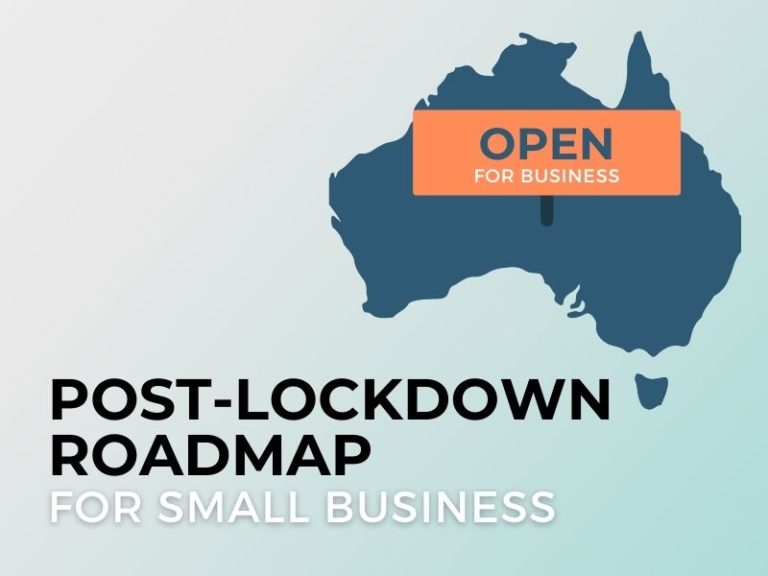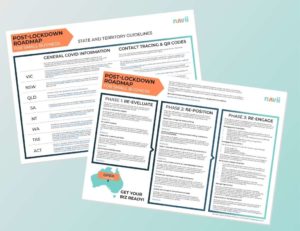As Australia gets closer and closer to the national vaccination targets and prepares to bid farewell to recurring lockdowns, small business owners need to consider what steps they need to take to prepare for life after lockdown.
This roadmap outlines 3 key steps small business owners need to take over the coming weeks in order to restart their operations as efficiently as possible and so they can hit the ground running.
We recommend allocating one week for each phase to give yourself enough time to complete all the actions.
The 3-phase plan of Re-Evaluating, Re-Positioning and Re-Opening has been built out of the experience & knowledge of having gone through Australia’s most recent 12 months of unprecedented change, unrest and lockdown. The consumer market has changed and you need to prepare your business to ensure a successful return to operating in a post-lockdown Australia.

You can download a copy of the Small Business Roadmap Out of Lockdown for free at the bottom of this page. The download also includes a directory of all the different state and territory guidelines and mandatory requirements including safety plans and contact tracing QR code registration.
Phase 1: Re-Evaluate
Phase one is all about strategic planning and re-evaluating your identity as a business, who your customers are and what your opportunities are in a post-lockdown market.
For this step, you will be taking a look inwards and a look around at your competitors to get a better understanding of what you are doing well and where you have room for improvement. The activities you complete in this step should help to inform the decisions you make as a business owner and guide your plan for the future.
Conduct a competitor analysis
Completing a competitor analysis will give you valuable insights about what other businesses in your market are doing to attract customers. The market is always changing but it is likely to have changed more rapidly during the volatile 18 months since the start of the pandemic. Analysing the branding, behaviour and digital presence of your competitors will give you a better sense of how other businesses in your industry have responded to the changes in the market and will offer some inspiration for your own business plans.
Do a SWOT analysis
A SWOT analysis is a fantastic planning tool for small businesses. This process will reveal the strengths, weaknesses, opportunities and threats within your business and the market that you operate in. Writing down all of these internal attributes and external influences will give you a clear picture of what your next steps could be. It is then up to you to decide what the priorities are for your business and write out a 3, 6 or 12-month plan with a realistic timeline for implementation.
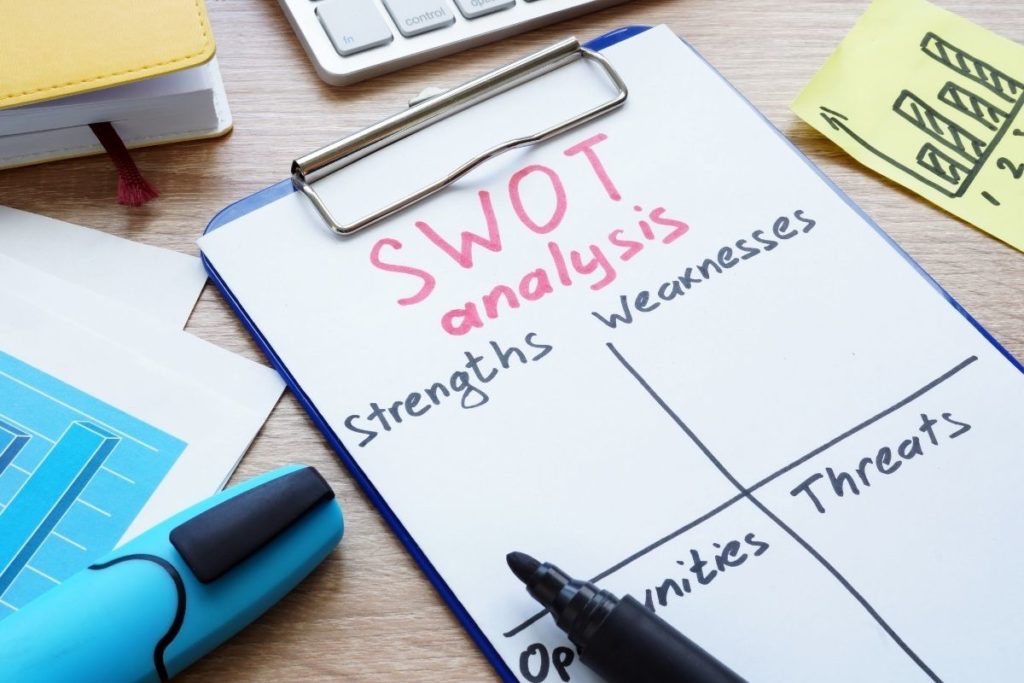
Create your customer personas
In order to have a crystal clear understanding of who your ideal customer is and their needs, you need to create your customer personas. In uncertain markets, like during COVID lockdowns, your target markets can change rapidly. This exercise will help you to personify your target markets, narrowing down their wants, needs, pain points and preferred marketing channels. This will in turn inform the way you communicate with them in your marketing.
Work out your brand promise
A Unique Selling Proposition, or USP for short, is a statement that captures what it is about your business that sets you apart from your competition. A USP works as your brand promise. It is a combination of what your business does well and what your ideal customer is looking for. It is important to have a well-written USP that you can use whenever you introduce your business to potential customers, whether it’s online or in person.
Phase 2: Re-Position
Phase one was all about creating clear definitions of what your business does well, who your target audience is, what opportunities are available to you and what you want to achieve in the near future. Now that you have this fresh clarity, you can tackle your online presence to ensure that it more accurately reflects your business values, serves your customers better and will help you to generate more business.
The six articles listed below each address one aspect of your online presence. If you are looking to channel more effort into a specific area of your business, such as your website or your social media channels, head to our blog page and use the filters on the left side of the page to sort the articles by topic.
Improve your local search ranking by updating your Google My Business listing
Your Google My Business listing is a powerful and free digital asset for your business and should be given an adequate amount of attention to ensure that it serves your customers and your business well. It is important to understand how Google ranks the businesses in local search results, and what you can do to influence where you appear in amongst your competition. Having a well-maintained Google My Business listing with plenty of positive reviews can be the difference between appearing in the top-3 results in a local search or not.

Create an automatic thank you email inviting customers to leave more reviews
Often one of the most difficult factors in building your online reputation is trying to encourage your happy customers to leave a review. Disgruntled customers are sometimes more eager to share their feelings via a review than happy ones and it is important that you drown out negative reviews with positive ones on platforms such as Facebook and Google. One great way to encourage more five-star testimonials is to send your customers a thank-you email after they have done business with you that provides links to your review platform.
Reply uniquely to any past reviews that you haven’t yet responded to
Once you have gathered some more reviews from your past customers, you must also ensure that you are staying on top of your review responses. The most important thing to remember about online review responses is that your words are not only addressing the reviewer but also any potential customers who are researching your business. Having unique and thoughtful responses to all of your online reviews demonstrates to both past and future customers that you care about your customers’ experience and that you value their feedback.
Create a list of Calls-to-Action for your Marketing Channels
Now let’s turn to your marketing strategy and consider how you might encourage your audience to interact with you. In this activity, you will create a list of calls-to-action that you can use for all of your future marketing content. A call to action should tell someone what you want them to do next or provide enough information to encourage people to take some type of action (e.g., learn more, subscribe, tag a friend, one-time offer or let us know in the comments below). Having a call to action at the end of your content will increase conversions by asking your customers to take an action every time you make a new post on Instagram, send out a newsletter or publish any other type of marketing communication.
Refresh your Facebook Cover Image and Caption
You only get one chance at a first impression. The thing that most influences your first impression on Facebook is your cover image. Having a beautiful cover image that is relevant to your business at the moment, that is eye-catching and that is tailored to your ideal customer can make your first impression so much better. It is also important to write a caption for your cover image that serves as an introduction with your USP and a call to action woven in.
Update your Instagram bio and business name
This quick and easy activity will increase your business’s search-ability on Instagram and allow you to better communicate who you are and what you do. First, you need to update your account name. Did you know that you have two names on your Instagram? There’s your username (aka your @handle) and your name. Updating your account name to include keywords will increase the reach of your account by making it easier to find using search terms in Instagram – see examples below.
Next you will need to optimise your Instagram bio. Your bio needs to capture the attention of your audience and quickly communicate your USP in 150 characters or less. Emojis, dot-points and hashtags can help you to create an engaging and effective bio.
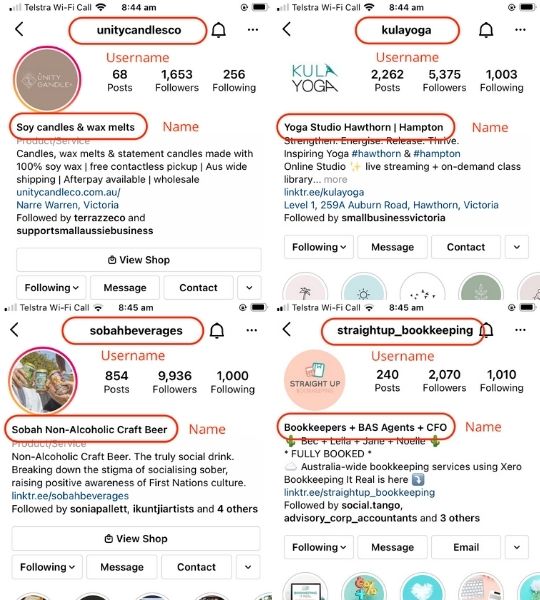
Phase 3: Re-Engage
The final phase of preparation is re-engaging your staff and your customers in the post-lockdown context. Your processes and the guidelines that you are permitted to work within may have changed, so you need to consider how you will respond to these changes and how you can communicate effectively with your audience.
Phases one and two lay the groundwork for the communication you will be doing in phase three so it is important that you have worked through that content first.
Re-engage your Employees
After months of working from home or not working at all, your employees are potentially feeling disengaged from your business. Re-onboarding your team will require you to communicate openly about your expectations and the needs of the business while also actively listening to their needs and priorities so that you can make the transition back to work as smooth as possible.
- Identify which staff members you will bring back on board.
- Confirm your staff are in good health to work and understand new workplace expectations.
- Consider whether you need to restructure your rostering system to minimise staff shortages in case of a COVID exposure.
- If you have had employees working from home until this point, consider whether they actually need (or want) to return to working on site. Can you create flexible working arrangements?
- Notify in an email or in a staff meeting any new health and safety procedures.
- Post signage in staff rooms. Written and verbal reminders will ensure your staff prioritise health and safety.
Re-engage your Customers
Depending on what industry you are in, your customers might be eagerly awaiting the news that you are open for business (we’re looking at you, 💇♀️ hairdressers!). Create a plan to cover all communication channels with a clear and effective message about how and when your business will be accepting customers again.
Communication methods:
- Email marketing
- Social media
- Write a Facebook post about your reopening and pin it to the top of your page
- Create an Instagram Story Highlight about when you are reopening and what’s changed
- Google My Business updates
- Website updates (FAQ page, banner at top of website, pop-up box)
What to include:
- Reopening date
- Opening hours (back to usual or have they changed?)
- Any changes to servies/products available (have you simplified your offering temporarily?)
- Conditions of entry
- Booking and cancellation policy
- Gift vouchers (especially in the lead up to Christmas!)
Be Proactive Instead of Reactive
Future-proof your business by planning for the unexpected.
- You may need to lockdown again in the event that your premises becomes a COFID exposure site. Consider what systems, communication and processes do you need to have in place in order to be able to shut down quickly and write a step-by-step plan that you and your team can follow.
- Monitor your competitors and other industry players to observe trends, learn from best practice businesses and stay up-to-date with changing consumer preferences.
- Keep an eye out for potential funding opportunities through government grants – providing you with an opportunity to develop a new product/service or campaign, access training for yourself and your staff or receive general financial assistance.
- Consider going cashless.
- Consult with your key business advisors, including bookkeepers and accountants, for guidance on how to best manage cash flow, investments and plan for future unforeseen events.
Manage Expectations
As each state and territory brings in new rules for gatherings and activities for those with/without a COVID vaccination, you need to be aware of your responsibilities as a business owner and communicate them clearly with your employees and customers. You can manage expectations by being open, transparent and learning how to have sensitive conversations with those who might resist these rules.
The Facebook post below by Cherry Bar in Melbourne explains their obligations as bar and music venue to only allow fully vaccinated patrons inside their premises. They clearly outline the position they are in as a small business and request empathy and understanding from their audience.
You can be upfront with your customers by writing a similar post for your Facebook page, Instagram account, including this information in your website’s FAQ page and sharing it via your newsletter and/or email booking confirmation.
Template for communicating your vaccination policy with your customers
Copy and paste the below template and edit it to suit your business and share it with your customers in as many ways as possible to ensure that you cover all bases. You may even like to print out a version of this letter to post up at the entrance to your building.
Below we have listed the places online where you can share this message:
- Social media posts
- Blog post
- Website FAQ page
- Google My Business update
- Email newsletter
- Booking confirmation
To our customers,
At [Business name] we are a small business with a team of [number of employees]. Like many small businesses, we’ve had a hard time during the pandemic coping with repeated lockdowns, reduced capacity for [customers in-store/bookings], and the stress of keeping everyone safe.
We pride ourselves on being a workplace that prioritises the health and safety of our customers, our staff and their families above all else. We have taken a number of steps to ensure that we are fulfilling our responsibilities to keep everyone safe, including:
– Limiting the number of people we can have in any space at one time
– Transitioning to remote work where possible
– Stringent sanitisation and cleaning procedures
– Requiring all staff and customers to wear a face-mask
– Facilitating contact tracing by requiring all customers, staff and visitors to check in to our premises
Now, we have another responsibility to add to this list. From [date] we will be reopening our doors and requiring all staff and customers entering our premises to be fully vaccinated against Covid-19. One of our team members will be checking that all customers have checked in using the [state] check-in app and asking to view their vaccination certificate.
If you do not show us your vaccination certificate we will not be able to let you into our [store/office/studio/salon/workshop].
As a [business-type], we desperately wish to return to doing what we love, [business activity]! We are also eager to start operating again at the highest capacity we can so that we can begin to make back some of the income that we have lost due to the pandemic.
We know as well as anyone that the road to recovery is a very bumpy one. The stress and anxiety of lockdowns and lost income has made people more emotional than usual. We kindly ask that you show our staff the respect they deserve as they do their jobs.
Please understand that these are the rules imposed upon us by our government and if we are to open our doors we must abide by them.
I sincerely hope we have your understanding and support. Stay safe and see you soon!
[Name], owner of [Business name].
Stay Mindful of Your Mental Health
You don’t need reminding that being a small business owner during a pandemic isn’t easy. Be mindful of how the ongoing uncertainty is impacting the mental health of yourself and your team.
Stay connected to your local network and online small business community groups and make use of mental health support resources to learn strategies for creating a mentally healthy workplace. Some online resources are listed below:
- Business.gov.au – Mental health and wellbeing support for business
- Mentally Healthy Workplaces during COVID-19 Guide (National Mental Health Commission)
- HeadsUp.org.au
- AHeadForBusiness.org.au/
- Partners in Wellbeing Helpline (Business Victoria)
- A small business owner’s guide to creating a mental health plan (Business Victoria)
- Mental health for small business (NSW Small Business Commissioner)
Download the Small Business Roadmap Out of Lockdown
The Small Business Roadmap Out of Lockdown is available for download as a PDF via the form below. This includes a summary of the three phases outlined above with links to each of the resources.
The download also includes a directory of all the different state and territory COVID guidelines and mandatory requirements including safety plans and contact tracing QR code registration.
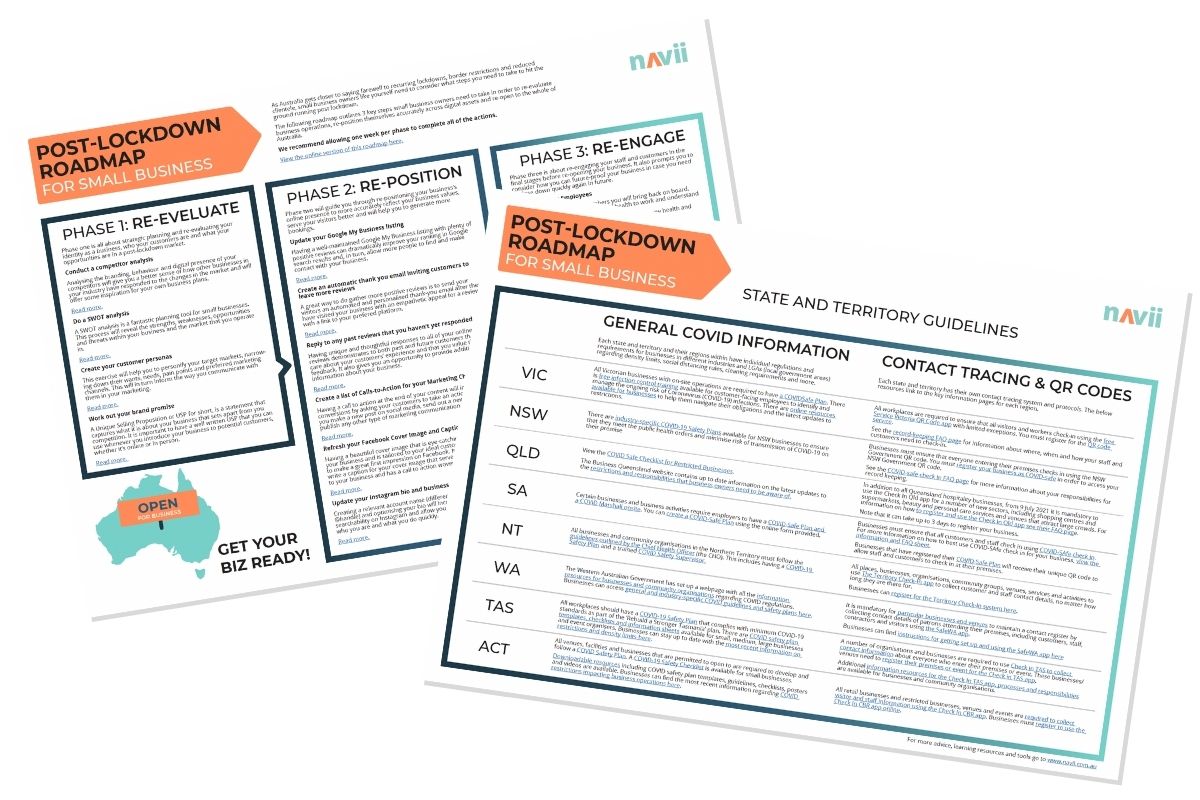
As you progress through each of these phases and beyond you can keep us up-to-date with your progress and questions in our Small Business Facebook support group as well as on our Instagram, Facebook and LinkedIn profiles.

